It is interesting to study some of the beautiful art work that has been created with “Mary Magdalene” as the subject. No figure in the Christian Pantheon except Jesus, the Virgin Mary, and John the Baptist has inspired, provoked, or confounded the imagination of painters more than the Magdalene. The artists’ perspective of this controversial early Christian saint is intriguing.
You may recognize some of this art, but do you know the artist? Do you know when the work was finished and where the original is located? You never know when you may be blessed by being close enough to one of them in your travels where you can actually see it in person, or even lucky enough to find and buy it at an auction or on-line.
Mary Magdalene interpretations….
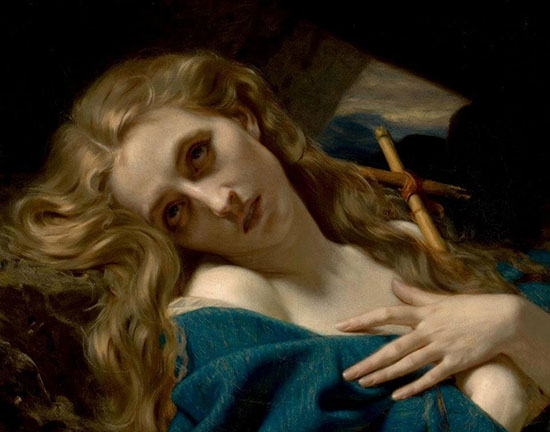 Mary Magdalene in the Cave by Hugues Merle, c. 1868
Mary Magdalene in the Cave by Hugues Merle, c. 1868
Hugues Merle (1823-1881) was a French painter who mostly depicted sentimental or moral subjects. He was born in 1823 in Saint Martin. He graduated from the École de Beaux-Arts, and was a member of the French Academy. Merle started exhibiting his work at the Paris Salon in 1847 at the age of 23. At that time the Salon de Paris was the greatest annual or biannual art event in the Western world. Merle favored emotion-filled, often seductive, facial expressions and languid bodies to connote drama and pathos. Indeed, his Mary Magdelene emerges as the enraptured captive of Christ’s love. Merle died at an early age of 58 and is considered to be one of the forgotten masters.
This oil on canvas is 17-3/4 x 23-1/2 inches (45.1 x 59.7 cm) and is signed and dated lower left: Hugues Merle 1868.
Mary Magdalene in the Cave was part of a private collection in Amsterdam. It actually went up for auction on June 21, 2014 at Heritage Auctions in Dallas, Texas! The highest bidder was very fortunate to carry home such a gorgeous rendition!
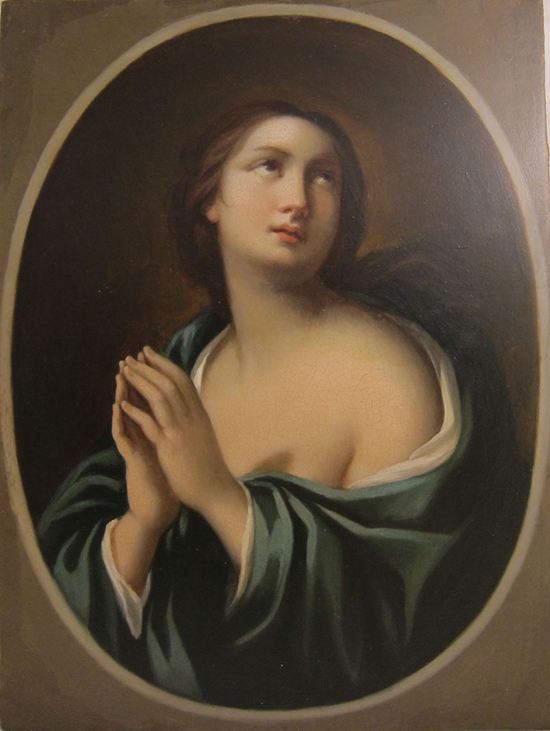 Antique Religious Oil Painting of a Mary Magdalene, c. Early XIX
Antique Religious Oil Painting of a Mary Magdalene, c. Early XIX
This superb religious oil painting of a Mary Magdalene depicts her as a beautiful young woman. She is wearing a blue and white gown exposing a naked left shoulder. It was painted in the old master style. I don’t believe the artist’s name is known.
It is an oil painting on board and measures 8.75 x 11.5 inches. The painting was actually for sale in May 2014 at the on-line antique store Historic Shop, located in New York City. I can’t believe I discovered another treasure that could actually be purchased!
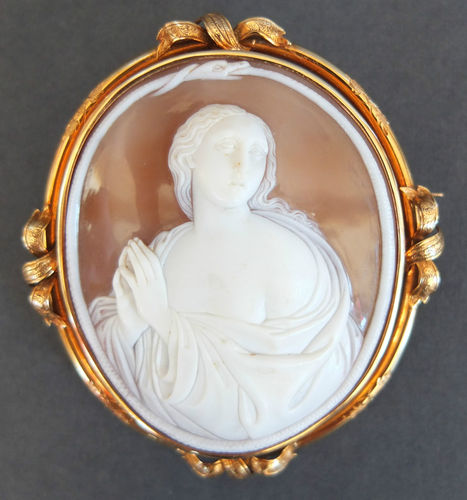 CAMEO of Antique Religious Oil Painting of a Mary Magdalene, c. Early XIX
CAMEO of Antique Religious Oil Painting of a Mary Magdalene, c. Early XIX
In August 2014 I was contacted by a woman named Judith who apparently purchased the Antique Religious Oil Painting of a Mary Magdalene, c. Early XIX above because it was an identical image of the one on the cameo she had in her collection – see above. Judith is a collector of cameos and has a cameo resource site called CameoTimes. Thank you Judith for your contribution of the photo of the Mary Magdalene cameo.
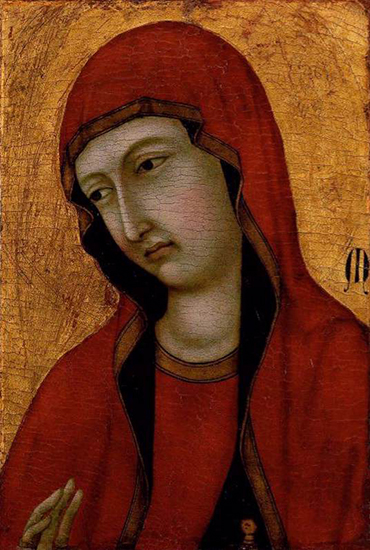 Saint Mary Magdalen by Ugolino di Nerio, c. 1320
Saint Mary Magdalen by Ugolino di Nerio, c. 1320
Ugolino di Nerio (1280? – 1349) was born in Siena to a family of painters. He emerged as an independent master around 1315. From about 1320 a distinct mature style emerges, spiritual and elegant. Saint Mary Magdalene is tempura on panel measuring 37 x 25 cm. This painting resides in the Museum of Fine Arts in Boston.
Evidence of di Nerio’s fondness for painting pious subject matter can be seen in his iconic depictions of Saint Mary Magdalene and Saint Louis of Toulouse.
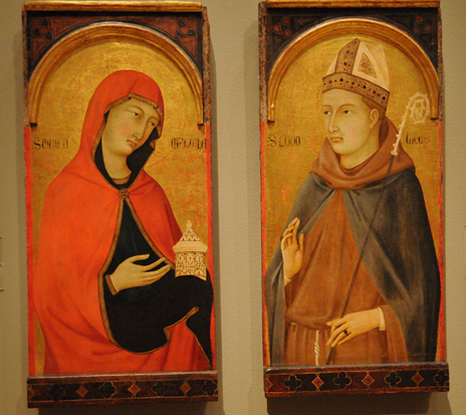 Saint Mary Magdalene and Saint Louis of Toulouse by Ugolino di Nerio, c. 1328
Saint Mary Magdalene and Saint Louis of Toulouse by Ugolino di Nerio, c. 1328
Both of these paintings utilize the rich and vibrant colors that he was known for taking advantage of, especially since the dominant colors in these two particular pieces are bright red and gold. These paintings are timelessly cherished by people around the world today due to di Nerio’s noble tribute towards the great saints and they currently reside in the de Young Legion of Honor in San Francisco.
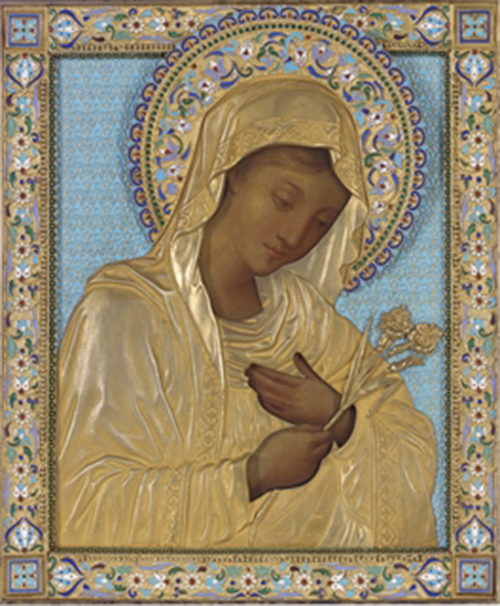 ST. MARY MAGDALENE RUSSIAN, c. 1890
ST. MARY MAGDALENE RUSSIAN, c. 1890
Saint Mary Magdalene is portrayed here in three-quarter view, leaning forward with a sorrowful expression, bringing her left hand to her chest and holding two daffodils. Her stance is reminiscent of her mourning position under the Cross. Her face is rendered naturalistically and her body is covered in silver-gilt. The background is executed in light blue filigree enamel with a cut-out halo and raised border in polychrome floral and stylised cloisonné enamel. This icon measures 10 5/8 x 8¾ inches (27 x 22.3 cm).
Christie’s, the world’s largest fine art auction house, sold this icon of Saint Mary Magdalene for $55,652 in November of 2008 on King Street in London.
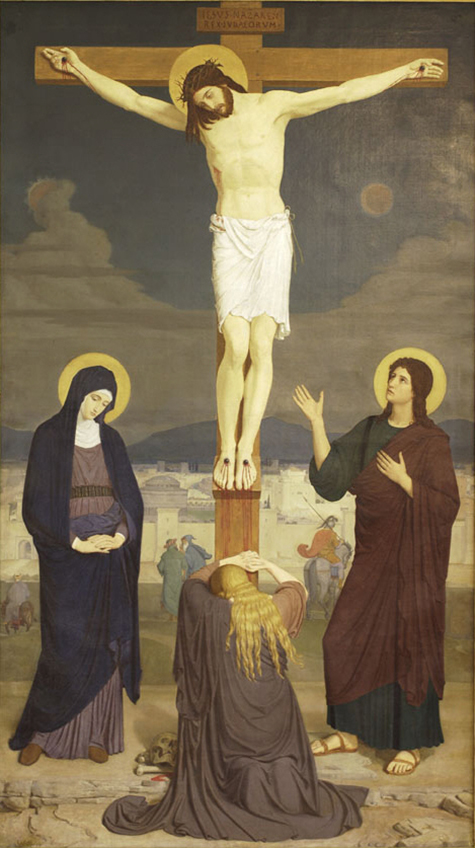 Stabat Mater by Gabriel Wüger, c. 1868
Stabat Mater by Gabriel Wüger, c. 1868
Gabriel Wüger (1829–1892) was born on December 2nd in Canton Thurgau in Switzerland. He was an artist and a Benedictine monk. He was one of the founders of the Beuron Art School in Germany in the late nineteenth century. In 1863 Wüger and two other Benedictines (Lenz and Steiner), traveled to Rome to work with the artists of the Nazarene movement. Like the Nazarenes, these artists who would become known as the “Beuronese” were in search of natural simplicity and clarity with an emphasis on essentials and conscious neglect of accidentals and details.
Lenz and Wüger thought of forming a monastic community of artists. They believed that in order to make sacred art one should lead a Catholic life in community. In 1868 in Rome, they met another Benedictine (Wolter) who had similar artistic aspirations for his young Benedictine monastery at Beuron. Maurus Wolter wanted his monastery to play a role in the revival of Church art just as it was beginning to do in the revival of Gregorian chant (in emulation of Solesmes). Lenz was attracted to Beuron because of the abbey’s use of Gregorian chant, which he saw as parallel to his own efforts in art and architecture. Wüger entered Beuron in 1870, followed by Steiner and Lenz in 1872. The original “Life of the Virgin” series was painted at the Emmaus Abbey in Prague under the direction of Lenz, Wüger, and Steiner between 1880-87.
In his apostolic letter Archicoenobium Casinense in 1913, on the occasion of the consecration of a crypt chapel at the abbey of Monte Cassino decorated in the style of the Beuron Art School, Pope Pius X likened the artistic efforts of the Benedictines of Beuron to the revival of Gregorian chant by the Benedictines of Solesmes when he wrote, “…together with sacred music, it proves itself to be a powerful aid to the liturgy.”
Stabat Mater, the title of the painting, is Latin for “the mother stood.” This is a topic in Christian Marian art in which the Virgin Mary is depicted under the cross during the Crucifixion of Christ.
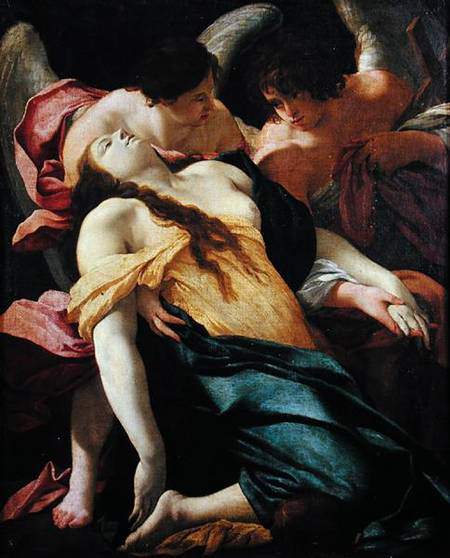 Mary Magdalene Carried by Angels by Simon Vouet
Mary Magdalene Carried by Angels by Simon Vouet
Simon Vouet (January 8, 1590 – June 30, 1649) was a French painter and draftsman, who today is perhaps best remembered for helping to introduce the Italian Baroque style of painting to France. His father was a painter in Paris and taught him the rudiments of art. At a young age he traveled to England. From there he went to Venice and was in Rome in 1614 at the age of 24.
He spent an extensive period of time in Italy, from 1613 to 1627. He was mostly in Rome where the Baroque style was emerging during these years. He received a pension from the King of France and had numerous famous patrons. He was a natural academic, who absorbed what he saw and studied, and distilled it in his painting: Caravaggio’s dramatic lighting; Italian Mannerism; Paolo Veronese’s color and perspective; and the art of Carracci, Guercino, Lanfranco and Guido Reni. Vouet’s immense success in Rome led to his election as president of the Accademia di San Luca in 1624.
Despite his success in Rome, Vouet suddenly returned to France in 1627 answering a summons from the King. In his time the art of painting began to be practiced here in a nobler and more beautiful way than ever before. Vouet’s new style was distinctly Italian, importing the Italian Baroque style into France.
Mary Magdalene Carried by Angels is an oil on canvas measuring 80 x 100 cm (31.4 x 39.3 inches). It resides in Besançon (eastern France) at the Musée des Beaux-Arts et d’Archéologie.
Carried by angels
The tradition of Mary Magdalene being raised up by angels began with a monk who was living in a cave close to La Sainte-Baume who saw a woman being carried with regularity by angels. He also heard their beautiful singing. He prayed to God to understand what he had witnessed and one day the woman spoke to him. She asked him if he knew of the Mary Magdalene who accompanied Jesus during his travels. When he replied “yes,” she explained that she was that Mary Magdalene and that she had been living in that cave for the last thirty years, and each day had been carried up by angels to receive nourishment and then carried back. Mary Magdalene then asked the monk to go down the mountain to the church in Tégulata where Maximin was and tell him that soon she would be coming to him because she was at the end of her life. The monk did as she requested and the news of her coming to see Maximin pleased the bishop very much. Mary Magdalene later appeared with angels in Bishop Maximin’s oratory where he gave her viaticum (food for the journey), and then she died in his arms. [1]
[1] The GOLDEN LEGEND or LIVES of the SAINTS, compiled by Jacobus de Voragine, Archbishop of Genoa, 1275.
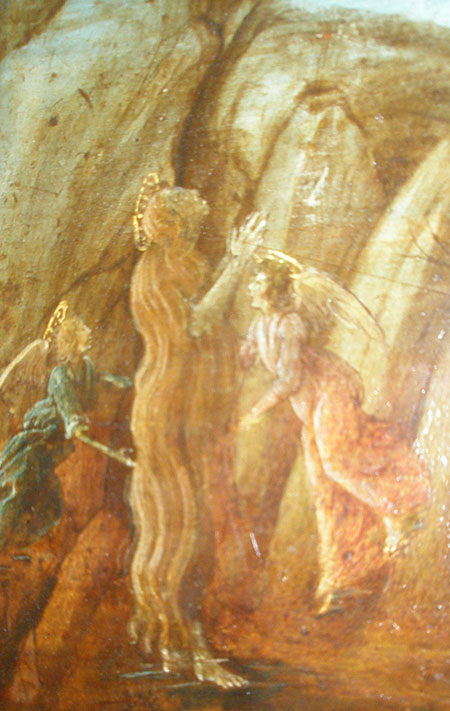 Carried by Angels by Sandro Botticelli, c. 1484-9
Carried by Angels by Sandro Botticelli, c. 1484-9
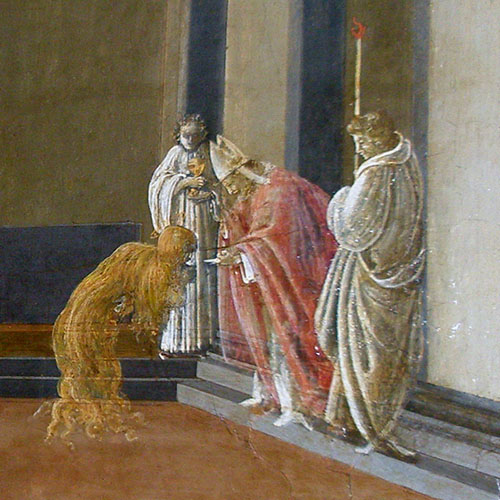 Mary Magdalene’s Last Communion (given to her by her dear friend St. Maximin) by Sandro Botticelli, c. 1484-9
Mary Magdalene’s Last Communion (given to her by her dear friend St. Maximin) by Sandro Botticelli, c. 1484-9
Sandro Botticelli (1445 – May 17, 1510), was born in Florence, Italy. He was an Italian painter of the Early Renaissance. By the age of fifteen Botticelli already had his own workshop and this helped form his distinctive artistic style. This style incorporated Neo-Platonism, a method that helped him appeal to many tastes by including Christianity and paganism in his works. Botticelli was already little employed in 1502. In 1504 he was a member of the committee appointed to decide where Michelangelo’s David would be placed. During his lifetime he was one of the most acclaimed painters in Italy, being summoned to take part in the decoration of the Sistine Chapel in Rome and earning the patronage of the leading families of Florence, including the Medici.
Mary Magdalene’s Last Communion is a scene from the Legend of Mary Magdalene and part of the John G. Johnson Collection at the Philadelphia Museum of Art. There are a number of other paintings of Mary Magdalene in the Johnson Collection. If you are ever in Philadelphia, it is really worth the trip to the museum to see the Johnson Collection.
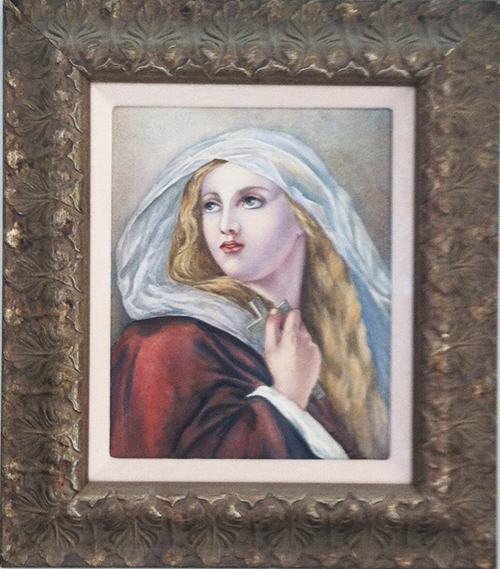 Marie-Madeleine by R. Eischmaninoff, c. 1868
Marie-Madeleine by R. Eischmaninoff, c. 1868
I found this original painting in 2009 at the Marché Forville, the outdoor antique market in Cannes, France. The merchant at the market had a collection of Eischmaninoff’s work even though he seems to be an unknown artist from Germany. Marie-Madeleine was the only religious piece in his collection. I love it and have it framed in my home. It has served as the cover image of my first book, A LOVE DEVOUT – The True Untold Story of Mary Magdalene and as the theme image for the Magdalene Publishing website. The painting is oil on board and measures 8 x 10 inches
It was a total surprise to me that I would come across something as beautiful as this painting while just enjoying the outdoor market in the South of France. Keep your eyes open and you may spot your treasure in a place you least expect.


Mary Magdalene in the Cave by Merle is just gorgeous. You get a real sense of the person in that one.
I purchased the painting of the hauntingly beautiful Magdalen, artist unknown, that you feature above. I found her while trying to research a cameo I have with the same image. Because I have seen at least 2 other cameos with this image, I know at one time it was familiar in Torre del Greco (outside of Naples), the center of cameo production, undoubtedly in reproduction form. I have found 2 other painted reproductions that have been auctioned by major houses in the last year. The one sold by Bonham’s is signed T. Berti, with an address in Florence. Bonham’s describes it as being after Carlo Dolci. However, after looking at what I can find of Dolci’s work, I am not convinced & have been looking at other Florentine painters. My researches took me to this page. 🙂
Thank you Judith for the information you provided on the Antique Religious Painting of a Mary Magdalene, (c Early XIX) featured above. How fortunate you are to now own it. I would love to see a photo of the cameo you have with the same image of Mary Magdalene. If you provide a photo I may insert it in this blog post. I looked at your website CameoTimes.com – it is very interesting.
Very interesting, Thank you well,worth a visit on this site i will visit again I have more knowledge of Mary now than i did before
Once again Thank you